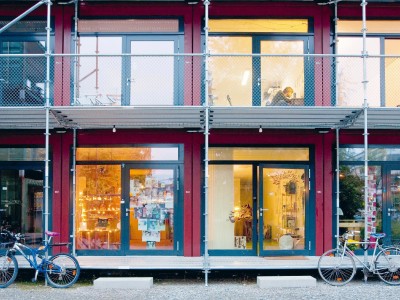
Kitchen – a living space
Due to the veritable hype that has surrounded healthy eating in recent years, cooking has achieved cult status, returning the kitchen to its former place as the epicentre of our social life. The kitchen’s new-found importance is reflected in the materials used and its design.
In former times, fire was the centre of our lives. People gathered around the hearth not only to prepare food, but also because it provided warmth and light. In mediaeval houses, the hearth was situated either at ground level or in a slightly raised position in the corner of the living space. People cooked, ate and lived in the kitchen. This so-called multipurpose kitchen was the norm in large areas of Switzerland until well into the 19th century. For many years, kitchens separated from the living area and used solely for food preparation remained the privilege of the upper classes.
However, health risks were involved in spending extended periods in kitchens as they were plagued by several shortcomings: air circulation left much to be desired because there were practically no chimneys through which smoke and steam could escape. Soot settled in every nook and cranny, daylight was scant, and water had to be fetched from wells in buckets. The kitchen, as the “Historical Lexicon of Switzerland” infers, was a hotbed of disease. But in the late 19th century, undesirable germs were gradually eradicated as awareness of hygiene grew. From then on, walls were tiled, and fresh water came from the tap rather than the well. Further improvements in comfort arrived in the course of the 20th century – gas and electricity were installed and wood-burning “fire boxes” fell into disuse. The refrigerator became an integral feature and superseded the wooden ice box. Lastly, the development of independent heating systems meant that the kitchen could be separated from the living room.
The kitchen becomes a laboratory
The 1920s brought one of the most fundamental changes. At the 1927 Frankfurt Spring Fair, the “Frankfurt kitchen” designed by Viennese architect Margarete Schütte-Lihotzky caused a considerable stir. It was configured to ensure the greatest possible efficiency in food processing. Because the family had to be fed quickly – many women had jobs as well as looking after their children at this time – the kitchen became a functional, standardised laboratory. It was now exclusively a workstation, closed off from the living and dining rooms.
New domesticity
After decades of purely functional use, the kitchen has been enjoying a renaissance as the epicentre of family life for some years. Cooking has become the subject of a veritable hype that extends from buying regional produce to careful preparation and preservation. Nowadays, hunting and gathering are the leisure activities of passionate cooks rather than a question of survival.
The new domesticity has led to a revival of hospitality and indulgence and is celebrated in time-consuming rituals. A paper published by the Gottlieb Duttweiler Institute in September 2017 even comes to the conclusion that “eating is the new pop music”. According to the authors, people no longer eat merely to fill their stomachs. Eating is more about physical comfort and lifestyle; it is equated with health and is intended to serve our inner well-being.
Made to measure
The prestige that cuisine enjoys is clearly reflected in kitchen design. The transition between living and cooking areas is seamless, and the greatest attention is paid to the materials used. What sets the tone in the rest of the house is also considered appropriate in made-to-measure kitchens – fine woods, natural stone, concrete or metals such as brass, stainless steel and copper. The kitchen has now become part of a harmonious whole. Increasingly, cooking methods that were once the privilege of professional chefs are now delighting their amateur colleagues. Sous vide or combination cookers, for example, now complement conventional ovens. To meet our high aesthetic criteria, technology can easily be hidden if necessary. Sliding doors and push-to-open systems ensure that appliances elegantly fade into the background when not in use.
Stars rather than horsepower
If weekday meals need to be prepared quickly, a growing number of connoisseurs declare the kitchen to be a gourmet temple weekend after weekend. The fact that the men of today discuss low-temperature cooking as heatedly as they do horsepower has possibly added further impetus to the process of digitisation in the kitchen. The oven can be controlled using an app on a mobile device and the fridge will tell our mobile phones what’s missing. The kitchen has become a status symbol and a serious competitor for the fleet of vehicles in the garage. However, the new digital functions don’t go down well with everyone: after a day at the computer, there is a great need to create something using your own hands. Pleasure in cooking has been reawakened and – more than ever – has made the kitchen a place of good taste.
Why is cooking trendy?
Cooking is trendy. What is the reason for the hype about food?
It can perhaps be understood as a ritual to compensate for the disappearance of the realities of cooking – the time that we can devote to this activity and the threat to which our food production is exposed.
How has this new passion for cooking changed the kitchen’s status?
If we think it through using this anthropological perception, it must be added that every ritual works according to aesthetic and formal rules as well as fetishes. Not only has the kitchen reconquered its social importance as a meeting place in the house as well as its symbolic role as the “hearth of the family” (even if perhaps no cooking is done there), it is also the scene of the meticulously planned and controlled presentation – of cooking.
“The kitchen is the scene of the meticulously planned and controlled presentation – of cooking.”
Which social developments of the 20th century have had the greatest impact on the way we cook?
Like so many aspects of today’s reality, I would ascribe the changes in the way we cook and eat primarily to the fundamental upheavals caused by industrialisation, the radical transformation of the pace of life, the rationalisation of time and space, and the separation of and distance between food production and consumption. Of course, women are required to be the protagonists in this scenario as they bore the burden of responsibility for the household for many centuries. When industry, and later also the services sector, put women on the job market, their areas of activity in the home were curtailed. This included cooking. Many of the resources made available by technology and the food industry are aimed primarily at reducing the effort required.
Men have conquered the kitchen. Do they cook differently to women?
Men have always claimed a certain segment of cooking for themselves. To this day – according to the prehistoric, patriarchal clan customs of hunter-gatherers – the meat or an entire fish, in other words the quarry, is left to male gastronomic expertise. Ars gastronomica – culinary art (rather than everyday cooking) – is also a traditionally male preserve, for which star chefs such as François-Pierre de La Varenne (1618–1678) were celebrated at the courts of Europe as of the 17th century, or even Paul Bocuse, the French star of nouvelle cuisine, who died in January.
What impact has “the man in the kitchen” had on its organisation, appliances or design?
As the realm of gentlemen conjurers, the kitchen has become a stage set for cooking. In other words, for the representation of sophistication, cosmopolitanism, luxury, sensuality, technical perfection, control and spending power. This is of course reflected in the aesthetics of kitchens, which now incorporate “precious” natural materials and attach great importance to the design message, while the fetishist approach to technical appliances lends them a high-tech air. The kitchen laboratory of the 1950s and 60s, devised with practicality in mind in order to rationalise women’s work, has been transformed into an oasis of leisure featuring professional design.
Which kitchen and cooking trends are emerging for the future?
The more general question of accommodation in the cities will probably have a decisive influence on the kitchens of the future. We shall see whether, in view of the real lack of room, cultural expectations in terms of space can be fulfilled. If we consider the figures of the trend towards our nutrition being increasingly delegated to industry and external suppliers, the kitchen’s primary function would indeed appear to be under threat. Perhaps the key to its future manifestation will lie in its social function.







